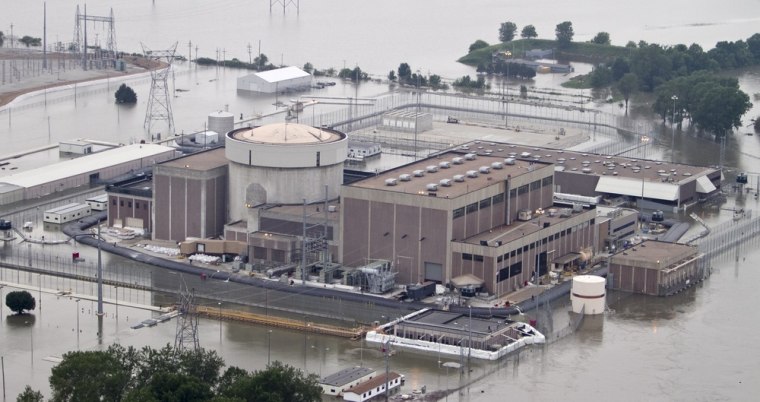Pictures of a nuclear power plant near Omaha show the facility surrounded by Missouri River floodwaters that have risen nearly to the reactor building.
But nuclear regulators and the utility that runs the Fort Calhoun reactor say the photos that attracted attention this week are little cause for immediate concern.
The plant, encircled by a giant rubber barrier, has been shut down since April. The Omaha Public Power District says the complex will not be reactivated until the flooding subsides.
And unlike Japan's infamous Fukushima Dai-ichi plan, the entire facility 20 miles north of Omaha still has full electrical power for safety systems, including those used to cool radioactive waste. It also has at least nine backup power sources.
The Fort Calhoun plant "is safe and it will continue to be safe throughout this flooding situation," said Dave Bannister, chief nuclear officer for the power district.
In another contrast to the March 11 tsunami in Japan, the Missouri River flooding has been predicted for weeks, so there was plenty of time to prepare.
Flooding remains a concern all along the river because of the massive amounts of water the Army Corps of Engineers is releasing downstream. The river is expected to rise as much as 5 to 7 feet above flood stage in much of Nebraska and Iowa and as much as 10 feet over flood stage in parts of Missouri.
The corps expects the river to remain high at least into August because of heavy spring rains in the upper Plains and substantial Rocky Mountain snowpack that will melt into the river basin.
Workers at the plant are still able to get inside the building and remain dry by using walkways that rise above the water.
The river has risen 1.5 feet higher than Fort Calhoun's 1,004-foot elevation above sea level, but the water is being held back by a series of protective barriers, including an 8-foot rubber wall outside the reactor building.
Bannister said Fort Calhoun can be fortified to handle water up to 1,014 feet above sea level.
The rubber barrier surrounding the plant is designed primarily to protect external equipment, not the reactor itself, which Banister said is encased in a watertight room. The building housing the reactor has been fortified with steel plates on the outside and a series of internal barriers.
Nuclear Regulatory Commission spokesman Victor Dricks said Friday that both the Fort Calhoun plant near Blair and Nebraska Public Power District's Cooper plant near Brownville are safe.
"We think both plants are taking appropriate action," Dricks said.
The Cooper plant remains dry and is less of a concern because it is further from the river. Cooper is at 903 feet elevation, and Dricks said the river there is not predicted to climb above 900 feet.
But utility officials are monitoring the river levels closely, and they have installed some barricades around the plant as a precaution.
The river would have to climb to 902 feet at Brownville before officials would shut down the plant as a precaution.
